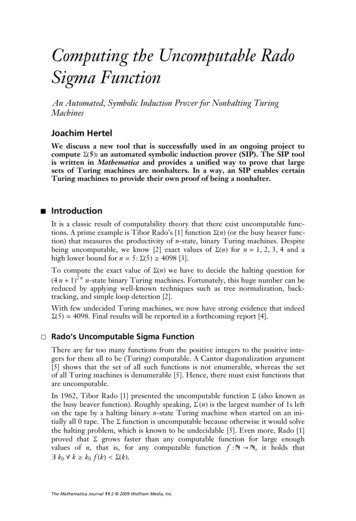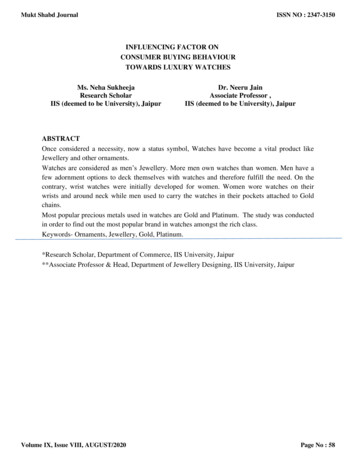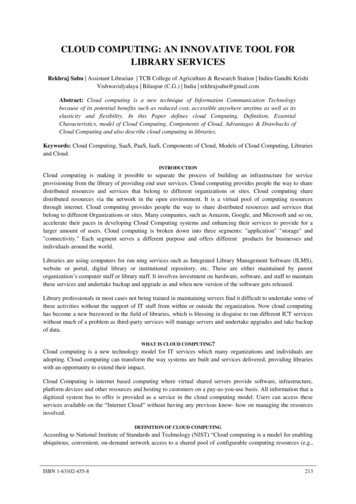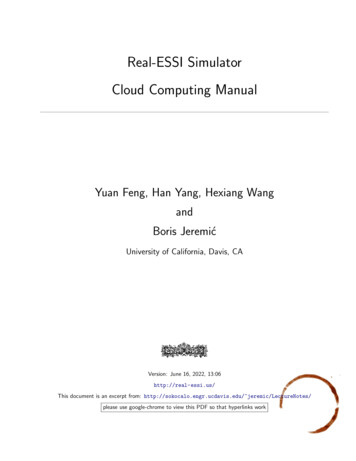
Transcription
The Mathematica JournalComputing the Uncomputable RadoSigma FunctionAn Automated, Symbolic Induction Prover for Nonhalting TuringMachinesJoachim HertelWe discuss a new tool that is successfully used in an ongoing project tocompute SH5L: an automated symbolic induction prover (SIP). The SIP toolis written in Mathematica and provides a unified way to prove that largesets of Turing machines are nonhalters. In a way, an SIP enables certainTuring machines to provide their own proof of being a nonhalter.‡ IntroductionIt is a classic result of computability theory that there exist uncomputable functions. A prime example is Tibor Rado’s [1] function SHnL (or the busy beaver function) that measures the productivity of n-state, binary Turing machines. Despitebeing uncomputable, we know [2] exact values of SHnL for n 1, 2, 3, 4 and ahigh lower bound for n 5: SH5L 4098 [3].To compute the exact value of SHnL we have to decide the halting question forH4 n 1L2 n n-state binary Turing machines. Fortunately, this huge number can bereduced by applying well-known techniques such as tree normalization, backtracking, and simple loop detection [2].With few undecided Turing machines, we now have strong evidence that indeedSH5L 4098. Final results will be reported in a forthcoming report [4].· Rado’s Uncomputable Sigma FunctionThere are far too many functions from the positive integers to the positive integers for them all to be (Turing) computable. A Cantor diagonalization argument[5] shows that the set of all such functions is not enumerable, whereas the setof all Turing machines is denumerable [5]. Hence, there must exist functions thatare uncomputable.In 1962, Tibor Rado [1] presented the uncomputable function S (also known asthe busy beaver function). Roughly speaking, S HnL is the largest number of 1s lefton the tape by a halting binary n-state Turing machine when started on an initially all 0 tape. The S function is uncomputable because otherwise it would solvethe halting problem, which is known to be undecidable [5]. Even more, Rado [1]proved that S grows faster than any computable function for large enoughvalues of n, that is, for any computable function f : Ø , it holds that k0 " k k0 f HkL SHkL.In 1964 Green [6] established general lower bounds for the S function for largervalues of n by explicitly constructing so-called class M Turing machines that generate long blocks of 1s. Julstrom [7] showed that Green’s class M Turing maThe Mathematica Journal 11:2 2009 Wolfram Media, Inc.chinesare related to the Ackermann function [5], a function that is computablebut not primitive recursive.
Computing the Uncomputable Rado Sigma Function271In 1964 Green [6] established general lower bounds for the S function for largervalues of n by explicitly constructing so-called class M Turing machines that generate long blocks of 1s. Julstrom [7] showed that Green’s class M Turing machines are related to the Ackermann function [5], a function that is computablebut not primitive recursive.Various computationally based approaches to make progress on the S functionhave been taken: brute force searches, genetic algorithms, heuristic behavior analysis, and many more [8]. The S function has become a classic topic in the theoryof computing [8]. For a comprehensive list of references on Rado’s S function,see [9].However, so far, exact values of SHnL have only been computed for n 1, 2, 3, 4(see [2, 8]): SH1L 1, SH2L 4, SH3L 6, SH4L 13. These values are the firstelements of the A028444 sequence of integers in The On-Line Encyclopediaof Integers [10].In 1990 Marxen and Buntrock [3] established the lower bound SH5L 4098, bypublishing a record-holding binary 5-state Turing machine that halts after47,176,870 steps and leaves 4098 1s on the tape.Michel [11] shows a connection of most of the known low n record-holding Turing machines and the Collatz 3 x 1 problem.There are three other related uncomputable functions associated with binary nstate Turing machines:Ë ShiftHnL: The maximum number of moves of a halting binary n-stateTuring machine started on an all 0 tape.Ë NumHnL: The largest unary number that can be created by a haltingbinary n-state Turing machine started on an all 0 tape.Ë SpaceHnL: The largest number of different tape cells scanned by a haltingbinary n-state Turing machine started on an all 0 tape.Ben-Amram et al. [12] prove that NumHnL § SHnL § SpaceHnL § ShiftHnL, " n.· Why Compute Values of Sigma?Chaitin argues that the S function is of considerable meta-mathematical interest.According to Chaitin [13], let P be a computable predicate of a positive integer nso that for any specific n it is possible to compute if P HnL is true or false. TheGoldbach conjecture is an example for P. The S function provides a crucial upper bound, for if P has algorithmic information content p, it suffices to examinethe first S HpL natural numbers to decide whether P is true or false for all naturalnumbers [13]. Hence, the S function enables converting a large but finite number of calculations into a mathematical proof. Calculating S HnL for specific valuesof n thus amounts to a systematic effort to settle all finitely refutable mathematical conjectures; that is, to determine all constructive mathematical truth [13].The Mathematica Journal 11:2 2009 Wolfram Media, Inc.
272Joachim Hertel· Minds, Machines, and SigmaThere is an ongoing philosophical discussion as to whether the human mind cansurpass the Turing limit or can be understood as a Turing machine. The famouslogician Kurt Gödel discusses his point of view that the mind can indeed surpassthe Turing limit in conjunction with his well-known incompleteness theorem.Gödel states in [14], that “although at each stage the number and precision of theabstract terms at our disposal may be finite, both may converge toward infinity inthe course of the application of the procedure”. Computing values of SHnL forincreasing n serves as a quantitative example for the situation Gödel is referringto. Indeed, Bringsjord et al. [15] present a “new Gödelian argument forhypercomputing minds” that is based on the S function. In their argument, the Sfunction provides a discrete way to measure the achievement of the human mind,surpassing the Turing limit and establishing new constructive mathematicaltruth. In [15] the core assumption is that if the human mind can compute SHnL, italso can compute SHn 1L, although that advance might take quite a long time.Experience from our ongoing project of computing S for 5-state binary Turingmachines shows that the halting question of large subsets of Turing machinescan be decided in a unified way. By using data mining to identify patterns and bythe subsequent use of an SIP, we can prove that these machines are in fact nonhalters once they reach a certain pattern when started on an all 0 tape. If wesucceed in identifying an induction base (i.e., some pattern), we then can use theSIP to operate as a kind of meta-Turing machine, enabling the underlyingTuring machine to create its own proof of being a nonhalter. Nothing in thatprocess is restricted to 5-state Turing machines. Hence we can imagine climbingbeyond n 5. The main challenge becomes the data mining part of identifyingsuitable induction base steps for the increasingly complex and “erratic” behaviorof Turing machines.We now turn in more detail to the computation of SH5L and to our maincomputational tool for that task the SIP for nonhalting Turing machines.‡ The Computation of Sigma for 5-State, Binary TuringMachines· Notations and DefinitionsBinary n-state Turing machines conform to these conditions:Ë The tape is infinite in both directions.Ë The tape alphabet is S 80, 1 .Ë The all 0 tape is called the blank tape W.Ë The Turing machine has n states, labeled 1, , n, and a halt state,labeled 0.Ë At each step the machine reads/writes the cell scanned by the Turinghead and moves the Turing head one cell to the left/right.Definition: The instruction table of a 5-state binary Turing machine M is a 5ä2table such that MHs, hL : 8ws, mv, ns , with s œ 81, 2, 3, 4, 5 , h œ 80, 1 ,ws œ 80, 1 , mv œ 8L, R , ns œ 80, 1, 2, 3, 4, 5 .The Mathematica Journal 11:2 2009 Wolfram Media, Inc.
Computing the Uncomputable Rado Sigma Function273Definition: The instruction table of a 5-state binary Turing machine M is a 5ä2table such that MHs, hL : 8ws, mv, ns , with s œ 81, 2, 3, 4, 5 , h œ 80, 1 ,ws œ 80, 1 , mv œ 8L, R , ns œ 80, 1, 2, 3, 4, 5 .We call s the current state of M and h the read symbol in the tape cell positionedunder the Turing head H. The triple 8ws, mv, ns is called a Turing instruction,with the write symbol ws being written into the tape cell positioned under theTuring head H, mv the move direction of the Turing head H, and ns the nextstate of M. If ns 0, M stops; otherwise, it continues executing instructions.Without loss of generality, we assume the halt instruction to be 81, R, 0 .That leaves us with H2 µ 2 µ 5 1L2µ5 2110 possible binary 5-state Turing machines. We call this finite set 5 .Let M œ 5 . MHWL means Turing machine M is started in state 1 on tape W.We definesHML : k MHWL halts and leaves k 1s on the tape0 otherwise.Here is an example of a a 5-state Turing machine first published by Marxen andBuntrock [3]:MMB81,81, 81,81,81,R, 2 R, 3 R, 4 L, 1 R, 0 81,81,80,81,80,L, 3 R, 2 L, 5 .L, 4 L, 1 MMB HWL halts after 47,176,870 steps and leaves 4098 1s on the tape; that is,sIMMB M 4098:SH5L : Max sHML .Mœ 5Hence, SH5L 4098 and we have to solve the halting question for a finite, but largenumber of Turing machines to compute the value of S H5L.ConfigurationsLet S* denote the set of finite words from the alphabet S. For x œ S* and y œ S*let x y denote the concatenated word.A machine configuration c is an expressionc 8s, 8w, 88x , 1 , h, 88 y , 1 , w , s œ 80, 1, 2, 3, 4, 5 , h œ S, x, y œ S* ,where w denotes the left/right infinite blank portion of the tape. In this notationW 8w, 0, w .The Mathematica Journal 11:2 2009 Wolfram Media, Inc.
274Joachim HertelWe use 88x , n : :8x, , x , 1 for all x œ S* to define symbolic configurationsn-timeswith multipliers n 1, as in c 8s, 8w, 88x , n , h, 88 y , m , w . For example,c 83, 8w, 0, 881, 0, 1 , k , w . That is, M is in state 3, the Turing head scans a 0cell, and the subtape 81, 0, 1 occurs k times.· General Approach: Discover and ProveBy using well-known techniques [2], such as tree normalization, backtracking, orsimple loop detection, the halting question can be decided for many of the 5state binary Turing machines.If we apply such techniques to the 2110 possible 5-state binary Turing machines,we find approximately 1,000,000 undecided machines (holdouts).For each of the remaining undecided Turing machines:Ë Iterate the holdout machine a “number of times”, starting on the blanktape W.Ë Save the configuration after each step.Ë Try to discover recurring patterns and store them as machineconfigurations.Here are some examples with x, y œ S* and the multiplier pn satisfying a recurrence relation pn 1 a pn b:cL HnLcR HnLcL HnLcR HnL: : : : 8s,8s,8s,8s,8w, h, 88x , a n b , w ,8w, 88x , a n b , h, w ,8w, h, 88x , 1 , 88 y , pn , w ,8w, 88x , 1 , 88 y , pn , h, w ,where n 0.Here are some actual examples of configurations.A simple linear configuration:c HnL 82, 8w, 0, 881 , 4 n , w .A simple exponential configuration:cHnL 81, 8w, 1, 880 , 3n , 881 , 3 , w .A more complicated configuration:cHnL 91, 9w, 0, 980, 0, 1 , 22 n 1 , 880, 1 , 3 , 980, 0, 1 , 22 n-1 , 880, 1 , 3 , , 980, 0, 1 , 23 , 880, 1 , 3 , 980, 0, 1 , 21 , 880, 1 , 3 , w .Once we have identified a reliable hypothesis for a recurring configuration c HnLof a Turing machine M, we try to create an induction proof showing that Mdoes indeed not halt.The general scheme is as follows:Step 1: Establish the induction proposition: M : Wïc HnL, " n 0 (i.e., Mtransforms the blank tape into c HnL in a countable number of steps).The Mathematica Journal 11:2 2009 Wolfram Media, Inc.
Computing the Uncomputable Rado Sigma Function275Step 2: Verify the base case; that is, check that M : Wïc HnL, n 0 (orany finite number n).Step 3: Formulate the induction hypothesis; that is, assume thatM : Wïc HkL, " 0 § k § n.Step 4: Prove the induction step; that is, M : Wïc Hn 1L, or equivalentlyM : c HnLïc Hn 1L.Step 4 involves the handling of symbolic configurations. This cannot be done byusing the Turing machine’s instruction table as it is, because the Turinginstructions are defined for numeric tape configurations only, not for symbolicconfigurations. For this we need the SIP, a kind of meta-interpreter that enablesthe Turing machine to produce its own induction proof of being a nonhalter.If the induction proof is successful, we know that the Turing machine M doesnot halt; hence, s HML 0. The induction proof might fail because of thefollowing.Ë The hypothesis is wrong (it is just based on a finite amount of tape data).Ë The proof does not terminate within the prespecified amount of CPUtime (i.e., it might go through if we allow more CPU time).Ë A situation is encountered beyond the implemented induction logic (weneed to enhance the prover).Ë A generalized Collatz (3 x 1) problem is encountered (see below).We now turn to a more detailed discussion of the SIP.‡ The Symbolic Induction Prover· Meta-InstructionsThe underlying idea is a unified and simple principle: analyze the Turing machine’sinstruction table and extract rules which describe meta-transactions on maximal invariant subtapes.For example, letsêh011**2H0, R, 5L*3H1, L, 3L*4**5*H0, R, 2LM Here is an example of a first-order meta-instruction:83, 8gl, 880 , n , 0, gr Ø 83, 8gl, 0, 881 , n , gr " n 1,where gl is the symbol for a general left tape and gr is the symbol for a generalright tape.If at time t, M has configurationThe Mathematica Journal 11:2 2009 Wolfram Media, Inc.
276Joachim HertelIf at time t, M has configurationct HnL 83, 8w, 88x , 1 , 880 , n , 0, 88 y , 1 , w for some x, y œ S* , we can apply the meta-instruction to getct 1 HnL 83, 8w, 88x , 1 , 0, 881 , n , 88 y , 1 , w .Here is an example of a second-order meta-instruction:82, 8gl, 0, 881, 0 , n , gr Ø 82, 8gl, 880 , 2 n , 0, gr " n 1.Note that a meta-instruction modifies an arbitrarily large countable portion ofthe tape.Induction SchemesThe SIP has a built-in library to support several induction proof schemes. Induction schemes are used in conjunction with meta-instructions to produce an induction proof for a nonhalting Turing machine. If necessary, the library can be enhanced with new induction schemes. We now discuss some of the implementedschemes.Scheme: Commutation Relations at the Tape BoundaryAssume Turing machine M exhibits the symbolic machine configurationcHkL 8s, 8w, h, 8x, k , 8q, 1 , w for some x, q .Verify: M : Wïc HkL for k 0.Assume: M : c Hk - 1Lïc HkL.Prove by Induction: M : c HkLïc Hk 1L.If true, M does not halt; hence, s HML 0.Induction Proof:Let M be in the configurationcHkL 8s, 8w, h, 8x, k , 8q, 1 , w .The SIP searches for maximal invariant boundary conditions and commutationrelations.Check If :èèM : 8s, 8w, h, 8x, 0 , 8q, 1 , gr ï8s, 8w, h, 8x, 1 , 8q, 1 , gr ,èèfor some q œ S* , such that q is a prefix of q.è è èèIf true, check further if x »» q q »» x for some x œ S* ; if this is also true, modifythe induction assumption to read:Extended Induction Hypothesis:èèM : 8s, 8w, h, 8x, k - 1 , 8q, 1 , gr ï8s, 8w, h, 8x, k , 8q, 1 , gr .The Mathematica Journal 11:2 2009 Wolfram Media, Inc.
Computing the Uncomputable Rado Sigma Function277The SIP proves this extended induction assumption as follows:è8s, 8w, h, 8x, k , 8q, 1 , gr è8s, 8w, h, 8x, k - 1 , 8x, 1 , 8q, 1 , gr èè8s, 8w, h, 8x, k - 1 , 8q, 1 , 8x, 1 , gr Husing the commutation relationLèè8s, 8w, h, 8x, k , 8q, 1 , 8x, 1 , gr è8s, 8w, h, 8x, k , 8x, 1 , 8q, 1 , gr Husing the extended induction hypothesisfor Hk - 1L # HkL on any grLHusing the commutation relationLè8s, 8w, h, 8x, k 1 , 8q, 1 , gr ‡Hence M : c HkLïc Hk 1L, " k 0 and M does not halt, meaning that s HML 0.Scheme: Cyclic Conditions at the Tape BoundaryAssume Turing machine M exhibits the symbolic machine configurationcHkL 8s, 8w, h, 8x, k , 8q, 1 , w ,for some x, q .Induction Base:Verify M : 8s, 8w, h, 8x, 1 , gr ï M : 8s, 8w, 8 y, 1 , h, gr .Induction Assumption:M : 8s, 8w, h, 8x, j , gr ï M : 8s, 8w, 8 y, j , h, gr , " j such that 1 § j § k - 1.Assume further that the instruction table of M results in meta-instructions:M1 : 8s, 8w, 8 y, n , h, 8ci , 1 , gr ö8s, 8w, h, 8x, n , 8ci 1 , 1 , gr , y, c0 , , cm œ S*M2 : 8s, 8w , 8 y, n , h, 8cm , 1 , gr ö8s, 8w, 8 y, n 1 , h, gr ,where c0 , , cm are the cyclic boundary conditions, with c0 8 .The Mathematica Journal 11:2 2009 Wolfram Media, Inc.
278Joachim HertelInduction Proof:8s, 8w, h, 8x, k , 8q, 1 , w 8s, 88w, h, 8x, k - 1 , 8x, 1 , 8q, 1 , w 8s, 88w, h, 8x, k - 1 , gr Hreplacing 88x, 1 , 8q, 1 , w by grL8s, 8w, 8 y, k - 1 , h, gr 8s, 8w, h, 8x, k - 1 , 8c1 , 1 , gr 8s, 8w, 8 y, k - 1 , h, 8c1 , 1 , gr 8s, 8w, h, 8x, k - 1 , 8c2 , 1 , gr ªHfirst use of induction hypothesisLHusing meta-instruction M1LHsecond use of induction hypothesisLHusing meta-instruction M1L8s, 8w, 8 y, k - 1 , h, 8cm-1 , 1 , gr IHm - 1Lth use of induction hypothesisM8s, 8w, h, 8x, k - 1 , 8cm , 1 , gr 8s, 8w, 8 y, k , h, gr 8s, 8w, h, 8x, k , 8c1 , 1 , gr 8s, 8w, h, 8x, k , 8c1 , 1 88x, 1 ,8q, 1 , w Husing meta-instruction M1LHuse of induction hypothesis and use of M2LHusing meta-instructionLHsubstituting back theexplicit right tape portionL8s, 8w, h, 8x, k 1 , 8p, 1 8q, 1 , w Hthis step might vary in other casesL8s, 8w, h, 8x, k 1 , 8q, 1 80, p , w 8s, 8w, h, 8x, k 1 , 8q, 1 , w for some p 0Hsubsuming the finite 0s into wL ‡Scheme: Decreasing Cell Sequence at the Tape BoundaryAssume Turing machine M exhibits:8s, 8w, h, 88A , n , 88B , 1 , 88R , k , gr k 0, an integerª8s, 8w, h, 88A , n , 88B , 2 , 88R , k - 1 , gr ª8s, 8w, h, 88A , n , 88B , j , 88R , k - j , gr Induction Base:Verify that for some function f :M : 8s, 8w, h, 88A , n , 88B , 1 , 88R , 1 , gr ö8s, 8w, h, 88A , n f H1L , 88B , 2 , gr Verify the swap meta-instruction:8s, 8w, h, 88A , n , 88B , k , 88R , 1 , gr ö8s, 8w, h, 88A , n k0 , 88B , 1 , 88R , k - 1 , 88B , 1 , gr The Mathematica Journal 11:2 2009 Wolfram Media, Inc.
Computing the Uncomputable Rado Sigma Function279Induction Assumption:M : 8s, 8w, h, 88A , n , 88B , k - 1 , 88R , 1 , gr ö8s, 8w, h, 88A , n f Hk - 1L , 88B , k , gr , for some function fInduction Proof:8s, 8w, h, 88A , n , 88B , k , 88R , 1 , gr 8s, 8w, h, 88A , n k0 , 88B , 1 ,88R , k - 1 , 88B , 1 , gr k-1:s, :w, h, :8A , n k0 ‚i 1Happly swap meta-instructionLf HiL ,88B , k , 88R , 0 , 88B , 1 , gr k-1:s, :w, h, :8A , n k0 ‚i 1Happly the induction assumptionk - 1 timesLf HiL ,88B , k 1 , gr Now, require thatk-1k0 ‚ f HiL f HkLi 1and hence f HkL k0 2k .Similar schema are also supported:8s, 8w, 88A , n , 88B , k , h, 88R , 1 , gr 8s, 8w, 88A , n k0 , 88B , 1 , h, 88R , k - 1 ,88X , 1 , gr Happly swap meta-instructionLand8s, 8w, 88A , n , h, 88B , k , 88R , 1 , gr 8s, 8w, 88A , n k0 , h, 88B , 1 , 88R , k - 1 ,88X , 1 , gr Happly swap meta-instructionLModular ArithmeticOften meta-instructions are subject to some modular condition.The Mathematica Journal 11:2 2009 Wolfram Media, Inc.
280Joachim HertelHere is an example:M : 8s, 8gl, 81, n , h, gr ös, gl, 881 , Mod@n, 3D , h, 80, 1, 0 , 3 Floorn3, grIf possible, the SIP calculates Mod@n, pD explicitly by using information about n.If the variable is of the form 2 n 1 and p 2, then Mod@2 n 1, 2D 1.In general, the SIP uses modular arithmetic in the finite ring n , includingFermat’s little theorem:Mod@a p , pD a, " a œ Integers, " p œ Primesand Euler’s generalization:ModAajHnL , nE 1, " a, n œ Integers.(Euler’s phi function jHnL gives the number of positive integers less than or equalto n that are relatively prime to n.)If nothing specific can be computed, the SIP picks a value v œ 80, , p - 1 andgenerates p subproofs, one for each of the possible v values at each decision pointin the general induction proof.· The Symbolic Induction Prover PackageThe SIP includes the following major functional packages to support meta-instructions and symbolic induction proofs for Turing machine configurations.metaservicescreates rules that represent meta-instructionsswapserviceshandles all orders of meta-instructionsshiftservicesshifts configurations into normalform to make them comparableCreate and execute meta-instructions.inductionservicesthe main package forinduction proof schemestracebufferservicesdetects emerging schemes bytracing the steps of an induction proof,producing induction assumptions,and invokes the SIP recursively for proofHandling of induction proofs.getgaugedvarservicehandles moduloarithmetic for symbolic variablesThe Mathematica Journal 11:2 2009 Wolfram Media, Inc.
Computing the Uncomputable Rado Sigma Functiongetgaugedvarservice281handles moduloarithmetic for symbolic variablesModulo arithmetic for symbolic variables.extremepointserviceshandles logic associated withmaximal invariant tape boundariesHandling boundary conditions.semaphoresupportprovides services to serialize inductionschemes to prevent “vicious circles”environmentservicesspecifies the proof environmentHe.g., global parameters, etc.LTechnical services.· ResultsStart with 5 , cardI 5 M 2110 .Applying well-known [2] and fast techniques, such as tree normal form, backtracking, and simple loop detection, leaves about 1,000,000 Turing machinesundecided.Ë 850,000 Turing machines are of a linear type, for example,8s, 8w, h, 8x, a n b , w for some x œ S* , or slightly more complexand are proved by the SIP to not halt.Ë 143,000 Turing machines are of polynomial or exponential configurations and are proved by the SIP to not halt.Ë 1,000 Turing machines are currently too complex for the SIP.Ë 900 have been manually proven to not halt.Ë 100 cases are still holdouts and are currently under consideration,but there is strong evidence that they do not halt.Ë 6,000 Turing machines halt within 50 106 steps.The Mathematica Journal 11:2 2009 Wolfram Media, Inc.
282Joachim HertelGiven that, we find that for the number of 1s (S) left on the tape, the numberof cells scanned (Space), and the number of moves (Shift), the Marxen andBuntrock [3] machine is the champion81,81,81,81,81,R, 2 R, 3 R, 4 L, 1 R, 0 81,81,80,81,80,L, 3 R, 2 L, 5 L, 4 L, 1 with:SH5L 4098ShiftH5L 47,176,870SpaceH5L 12,289.The largest unary number (i.e., empty tape with a single block of consecutive 1s)produced by any halting binary 5-state Turing machine is NumH5L 165.The Num champion is:81,81,81,80,81,R, 2 R, 3 R, 4 L, 1 R, 0 81,81,81,81,80,L, 1 L, 5 R, 5 R, 3 L, 2 The possibility exists that the halting question for one or more of the remainingholdouts is linked to the Collatz 3 x 1 problem (see also [11]). This is currentlyunder investigation, and the final results will be reported in a forthcoming paper[4].‡ References[1] T. Rado, “On Non-Computable Functions,” Bell System Technical Journal, 41, 1962pp. 877 884.[2] R. Machlin and Q. Strout, “The Complex Behavior of Simple Machines,” Physica D:Nonlinear Phenomena, 42, 1990 pp. 85 98, and references therein.www.eecs.umich.edu/ qstout/abs/busyb.html[3] H. Marxen and J. Buntrock, “Attacking the Busy Beaver 5,” Bulletin of the EuropeanAssociation for Theoretical Computer Science, 40, 1990 pp. 247 251.[4] J. Hertel, “The Computation of the Value of Rado’s Non-Computable S Function for5-State Turing Machines,” work in progress.[5] G. S. Boolos and R. C. Jeffrey, Computability and Logic, New York: Cambridge UniversityPress, 1989.[6] M. W. Green, “A Lower Bound on Rado’s Sigma Function for Binary Turing Machines,”in Proceedings of the Fifth IEEE Annual Symposium on Switching Circuit Theory andLogical Design, Princeton, NJ, 1964 pp. 91 94.[7] B. A. Julstrom, “A Bound on the Shift Function in Terms of the Busy Beaver Function,”ACM Special Interest Group on Algorithms and Computation Theory, 23(3), 1992pp. 100 106.The Mathematica Journal 11:2 2009 Wolfram Media, Inc.
Computing the Uncomputable Rado Sigma Function283[8] E. W. Weisstein, “Busy Beaver” from Wolfram MathWorld A Wolfram Web Resource.mathworld.wolfram.com/BusyBeaver.html[9] H. J. M. Wijers, “Bibliography on the Busy Beaver Problem,” 2004.www.win.tue.nl/ wijers/bbbibl.pdf[10] N. J. A. Sloane. “The On-Line Encyclopedia of Integer Sequences, SequenceId A028444.”oeis.org/search?q A028444&language english&go Search[11] P. Michel, “Busy Beaver Competition and Collatz-Like Problems,” Archive for Mathematical Logic, 32(5), 1993 pp. 351 367.[12] A. M. Ben-Amrein, B. A. Julstrom, and K. Zwick, “A Note on Busy Beavers and OtherCreatures,” Mathematical Systems Theory, 29(4), 1996 pp. 375 386.[13] G. J. Chaitin, “Computing the Busy Beaver Function,” Open Problems in Communicationand Computation (T. M. Cover and B. Gopinath, eds.), New York: Springer-Verlag, 1987pp. 108 112.[14] K. Gödel, “Some Remarks on the Undecidability Results,” Collected Works Volume II,Publications 1938 1974(S. Fefferman, J. W. Dawson, Jr., S. C. Kleene, G. H. Moore, and R.M. Soloway, eds.), New York: Oxford University Press, 1972/1990 pp. 305 306.[15] S. Bringsjord, O. Kellett, A. Shilliday, J. Taylor, Bram van Heuvein, Y. Yang, J. Baumes,and K. Ross, “A New Gödelian Argument for Hypercomputing Minds Based on the BusyBeaver Problem,” Applied Mathematics and Computation, 176(2), 2006 pp. 516–530.DOI Link: dx.doi.org/10.1016/j.amc.2005.09.071J. Hertel, “Computing the Uncomputable Rado Sigma Function,” The Mathematica Journal,2011. dx.doi.org/doi:10.3888/tmj.11.3–8.About the AuthorJoachim Hertel’s main area of research includes quantum computation and the theory ofcomputability. Hertel’s special interest is in the general topic “Minds and Machines”, particularly the question of what role Rado’s S function and Chaitin’s W number play in thiscontext.Joachim Hertel50 Main St, STE 1000White Plains, NY,10606jhertel@h-star.comThe Mathematica Journal 11:2 2009 Wolfram Media, Inc.
We call s the current state of M and h the read symbol in the tape cell positioned under the Turing head H. The triple 8ws, mv, ns is called a Turing instruction, with the write symbol ws being written into the tape cell positioned under the Turing head H, mv the move direction of the Turing head H, and ns the next state of M.










